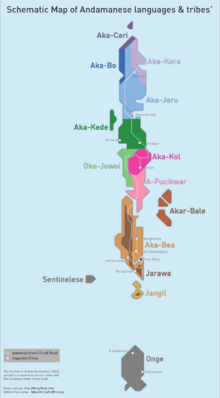Aka-Jeru language
| Jeru | |
|---|---|
| Aka-Jeru | |
| Native to | India |
| Region | Andaman Islands; interior and south North Andaman island, Sound island. |
| Extinct | 2009[1] |
|
Great Andamanese
| |
| Language codes | |
| ISO 639-3 |
Either:akj – Aka-Jerugac – Great Andamanese creole |
| Glottolog |
akaj1239 Aka-Jeru[2] |
 | |
The Jeru language, Aka-Jeru (also known as Yerawa, not to be confused with Järawa), is a Great Andamanese language, of the Northern group. Jeru was spoken in the interior and south coast of North Andaman and on Sound Island.
History
As the numbers of Great Andamanese progressively declined over the succeeding decades, the various Great Andamanese tribes either disappeared altogether or became amalgamated through intermarriage. By 1994, the 38 remaining Great Andamanese who could trace their ancestry and culture back to the original tribes belonged to only three of them (Jeru, Bo, and Cari).[3]
Whether the resulting Great Andamanese language was Jeru or a creole based on several languages, of which Jeru was a primary component, the last fluent speaker died in 2009.[1]
Grammar
The Great Andamanese languages are agglutinative languages, with an extensive prefix and suffix system.[4] They have a distinctive noun class system based largely on body parts, in which every noun and adjective may take a prefix according to which body part it is associated with (on the basis of shape, or functional association). Thus, for instance, the *aka- at the beginning of the language names is a prefix for objects related to the tongue.[4] An adjectival example can be given by the various forms of yop, "pliable, soft", in Aka-Bea:[4]
- A cushion or sponge is ot-yop "round-soft", from the prefix attached to words relating to the head or heart.
- A cane is ôto-yop, "pliable", from a prefix for long things.
- A stick or pencil is aka-yop, "pointed", from the tongue prefix.
- A fallen tree is ar-yop, "rotten", from the prefix for limbs or upright things.
Similarly, bēri-ŋa "good" yields:
- un-bēri-ŋa "clever" (hand-good).
- ig-bēri-ŋa "sharp-sighted" (eye-good).
- aka-bēri-ŋa "good at languages" (tongue-good.)
- ot-bēri-ŋa "virtuous" (head/heart-good)
The prefixes are,
| Bea | Balawa? | Bajigyâs? | Juwoi | Kol | |
|---|---|---|---|---|---|
| head/heart | ot- | ôt- | ote- | ôto- | ôto- |
| hand/foot | ong- | ong- | ong- | ôn- | ôn- |
| mouth/tongue | âkà- | aka- | o- | ókô- | o- |
| torso (shoulder to shins) | ab- | ab- | ab- | a- | o- |
| eye/face/arm/breast | i-, ig- | id- | ir- | re- | er- |
| back/leg/butt | ar- | ar- | ar- | ra- | a- |
| waist | ôto- |
Body parts are inalienably possessed, requiring a possessive adjective prefix to complete them, so one cannot say "head" alone, but only "my, or his, or your, etc. head".
The basic pronouns are almost identical throughout the Great Andamanese languages; Aka-Bea will serve as a representative example (pronouns given in their basic prefixal forms):
| I, my | d- | we, our | m- |
| thou, thy | ŋ- | you, your | ŋ- |
| he, his, she, her, it, its | a | they, their | l- |
'This' and 'that' are distinguished as k- and t-.
Judging from the available sources, the Andamanese languages have only two cardinal numbers — one and two — and their entire numerical lexicon is one, two, one more, some more, and all.[4]
References
- 1 2 Aka-Jeru at Ethnologue (18th ed., 2015)
Great Andamanese creole at Ethnologue (18th ed., 2015) - ↑ Hammarström, Harald; Forkel, Robert; Haspelmath, Martin; Bank, Sebastian, eds. (2016). "Aka-Jeru". Glottolog 2.7. Jena: Max Planck Institute for the Science of Human History.
- ↑ A. N. Sharma (2003), Tribal Development in the Andaman Islands, page 75. Sarup & Sons, New Delhi.
- 1 2 3 4 Temple, Richard C. (1902). A Grammar of the Andamanese Languages, being Chapter IV of Part I of the Census Report on the Andaman and Nicobar Islands. Superintendent's Printing Press: Port Blair.